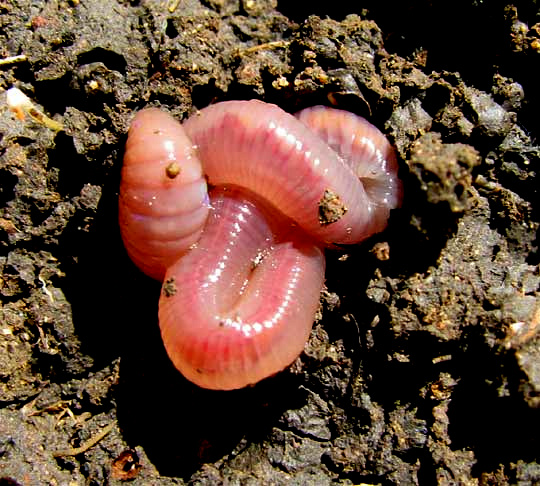Excerpts from Jim Conrad's
Naturalist Newsletter
from the June 7, 2009 Newsletter, issued from the Siskiyou Mountains west of Grants Pass, Oregon:
EARTHWORM ESTIVATION
When the soil gets very cold, very hot, very wet or very dry, it's hard on an earthworm. Survival strategies vary from species to species. A typical behavior is to tunnel deeper into the soil to where conditions aren't so extreme. Some species, especially during hot, dry periods, do what's shown below.

At a fair depth they roll themselves into balls and excrete mucous around themselves creating a kind of cocoon. In such a state their body functions slow down drastically. They go into a kind of suspended animation, waiting for soil conditions to improve.
When an animal enters such a state enabling it to survive summer's hot, dry conditions it's said that it estivates or "goes into estivation." This week I found the earthworm shown above as I worked in very dry, hard-caked garden soil. The earthworm lay inside a solid clod that broke apart like a brick. While the picture was being taken the worm began moving and I felt bad for having disturbed his dry-season repose.
from the December 16, 2001 Newsletter issued from the woods just south of Natchez, Mississippi, USA
SHOOTING EARTHWORMS
Speaking of earthworms, Tuesday morning as I visited my toilet I was staring at a spot in the leaf litter not far away when suddenly shiny earthworms began shooting up between the leaves and spreading in all directions. It's astonishing how fast earthworms can move when they want to. In a few seconds I understood what was going on, when the leaves from which the worms were emerging suddenly humped up, obviously being nudged from below. An Eastern Mole was tunneling there and the earthworms were doing their best to escape it. I've seen this before. When it occurs in a manicured lawn where fallen tree leaves do not obstruct their rush from the soil, earthworms just squirt from the ground and it's hilarious to see.